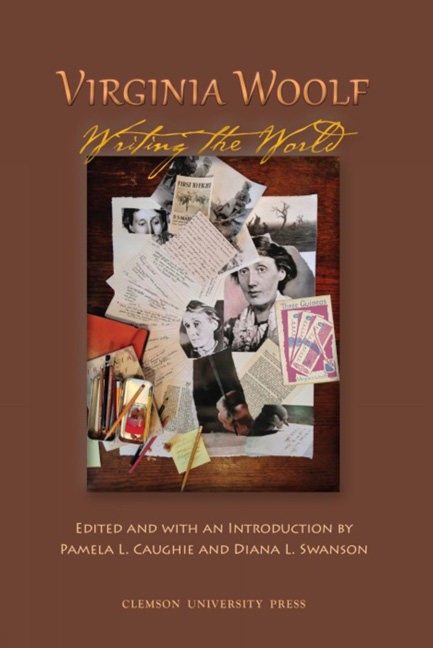Book contents
- Frontmatter
- Table of Contents
- Introduction
- Acknowledgmen
- Abbreviation
- WAR AND PEACE
- Roundtable: Woolf and Violence
- Intersections: Surveillance, Propaganda, and Just War
- Modernism and Memorials: Virginia Woolf and Christopher Isherwood
- Taking Up Her Pen for World Peace: Virginia Woolf, Feminist Pacifist. Or Not?
- The Sex War and the Great War: Woolf's Late Victorian Inheritance in Three Guineas
- Sky Haunting: The British Motor-Car Industry and the World Wars
- The 1914 “Expurgated Chunk”: The Great War in and out of The Years
- “beauty, simplicity and peace”: Faithful Pacifism, Activist Writing, and The Years
- Virginia Woolf, Katharine Burdekin, and Britain's Cosmopolitan Musical Culture
- Death in the Air: Virginia Woolf and Sylvia Townsend Warner in World War II
- WORLD WRITER(S)
- ANIMAL AND NATURAL WORLD
- WRITING AND WORLDMAKING
- Notes on Contributors
- Conference Program
- Appendix: Virginia Woolf Conference Exhibit Items, Newberry Library
The 1914 “Expurgated Chunk”: The Great War in and out of The Years
from WAR AND PEACE
- Frontmatter
- Table of Contents
- Introduction
- Acknowledgmen
- Abbreviation
- WAR AND PEACE
- Roundtable: Woolf and Violence
- Intersections: Surveillance, Propaganda, and Just War
- Modernism and Memorials: Virginia Woolf and Christopher Isherwood
- Taking Up Her Pen for World Peace: Virginia Woolf, Feminist Pacifist. Or Not?
- The Sex War and the Great War: Woolf's Late Victorian Inheritance in Three Guineas
- Sky Haunting: The British Motor-Car Industry and the World Wars
- The 1914 “Expurgated Chunk”: The Great War in and out of The Years
- “beauty, simplicity and peace”: Faithful Pacifism, Activist Writing, and The Years
- Virginia Woolf, Katharine Burdekin, and Britain's Cosmopolitan Musical Culture
- Death in the Air: Virginia Woolf and Sylvia Townsend Warner in World War II
- WORLD WRITER(S)
- ANIMAL AND NATURAL WORLD
- WRITING AND WORLDMAKING
- Notes on Contributors
- Conference Program
- Appendix: Virginia Woolf Conference Exhibit Items, Newberry Library
Summary
Correctly identified by Karen Levenback as set in 1914 instead of 1917, the first of two “expurgated chunks” from The Years originally served to bridge the prewar 1914 section, ending with Kitty Lasswade's arrival at her home in the north of England, and the 1917 section of the novel beginning with Eleanor Pargiter's exit from the omnibus into the wartime blackout of a winter's night in Westminster. Set in the late afternoon and evening of September 1914 (in the first holograph version October), this section, omitted late in the galley proof stage in 1936, provides an unusually vivid range of responses to the war from diverse class perspectives. It illustrates what Mark Hussey has called the “polyphony of private and public voices” that one detects in Woolf's late fiction and nonfiction (12). It also provides a signal instance of what John Whittier-Ferguson terms Woolf's “inventively exhausted prose” in her late writings of the1930s (231) as the characters try to find words to articulate their responses to the first phase of the war. In what follows, I read the omitted 1914 section both in its more expansive holograph form and in the considerably amended galley proof stage as Woolf's attempt to give, like both war memoirist D. Bridgeman Metchim and historian R.H. Gretton, a lived, authentic experience of the war outside of both newspapers and trenches.
Beginning with “A View From the Street,” as Woolf titled her 1919 review of Metchim's book on the war, the expurgated section follows the pensioned Pargiter servant Crosby as she marshals her landlady's children across a Richmond street into Kew Gardens. The section aff ords an unusual glimpse into Woolf's original method of delineating a range of civilian responses to the early stages of the war. Moreover, the holograph version reveals a deeper engagement with the disparate civilian views and off ers a far more astute commentary on how representatives of lower, middle, and upper-middle classes responded to one of the early disasters of the war—the sinking of three British cruisers in the North Sea on September 23, 1914—than do the galley proofs.
- Type
- Chapter
- Information
- Virginia Woolf: Writing the World , pp. 55 - 62Publisher: Liverpool University PressPrint publication year: 2015



